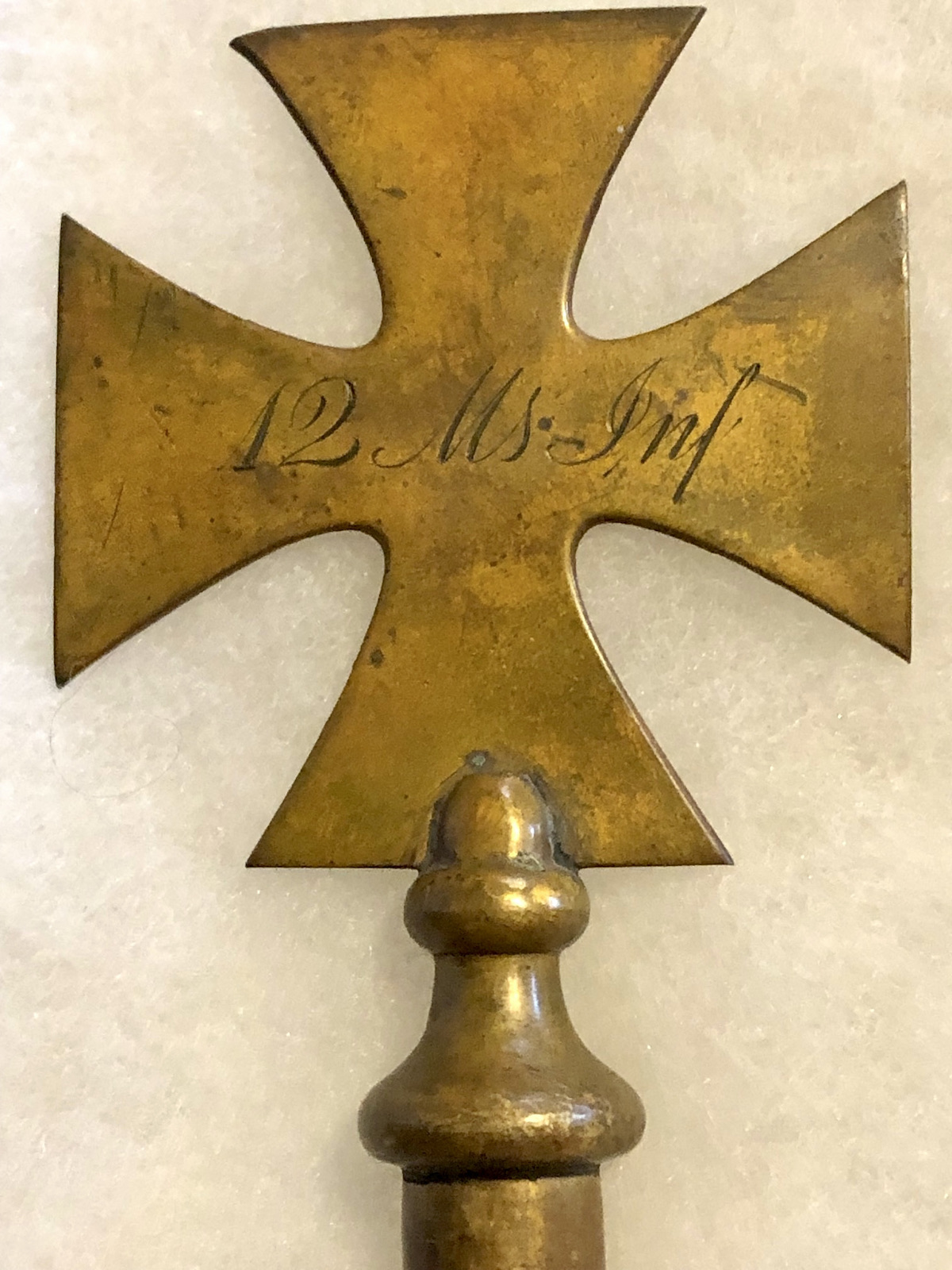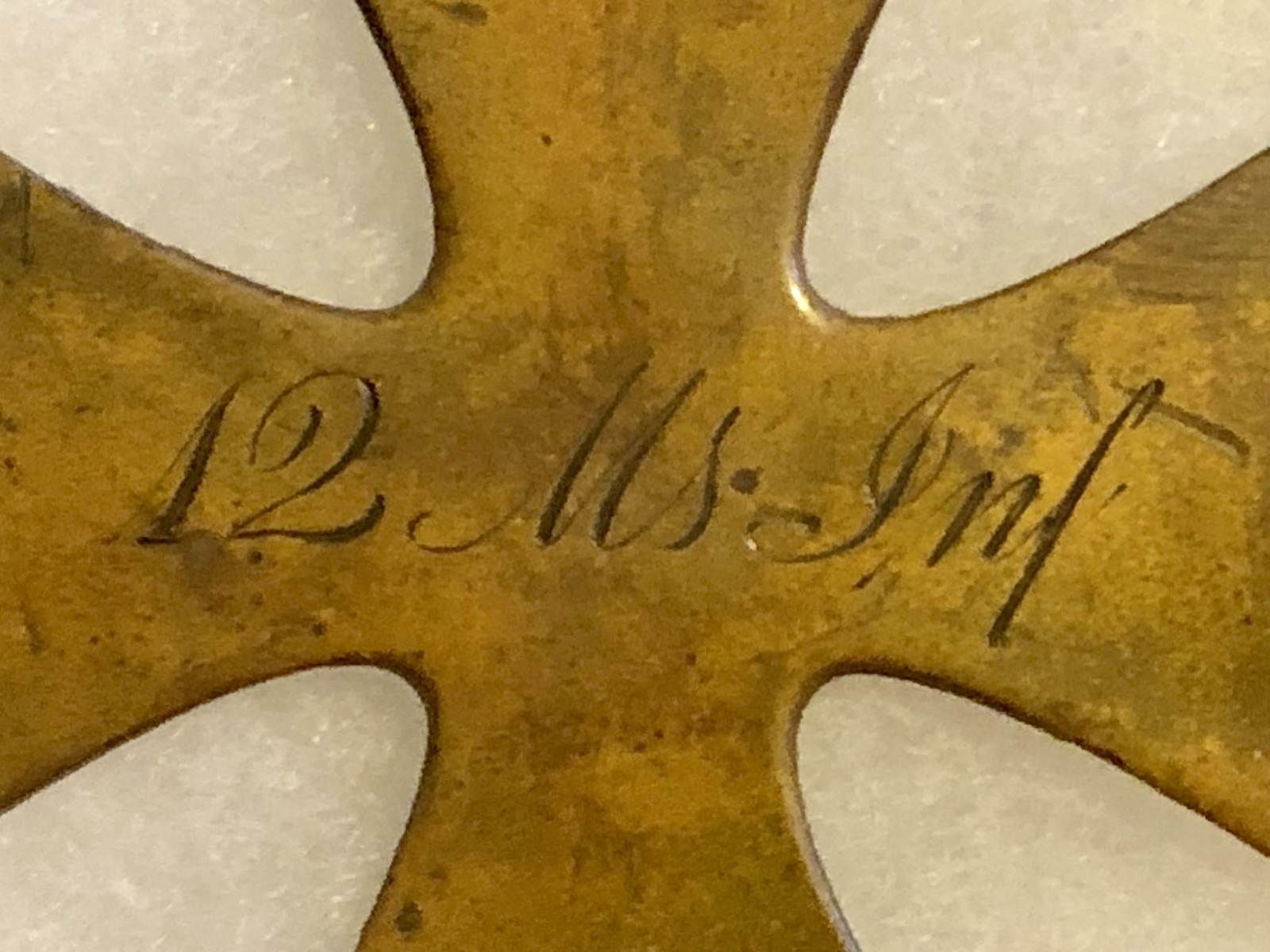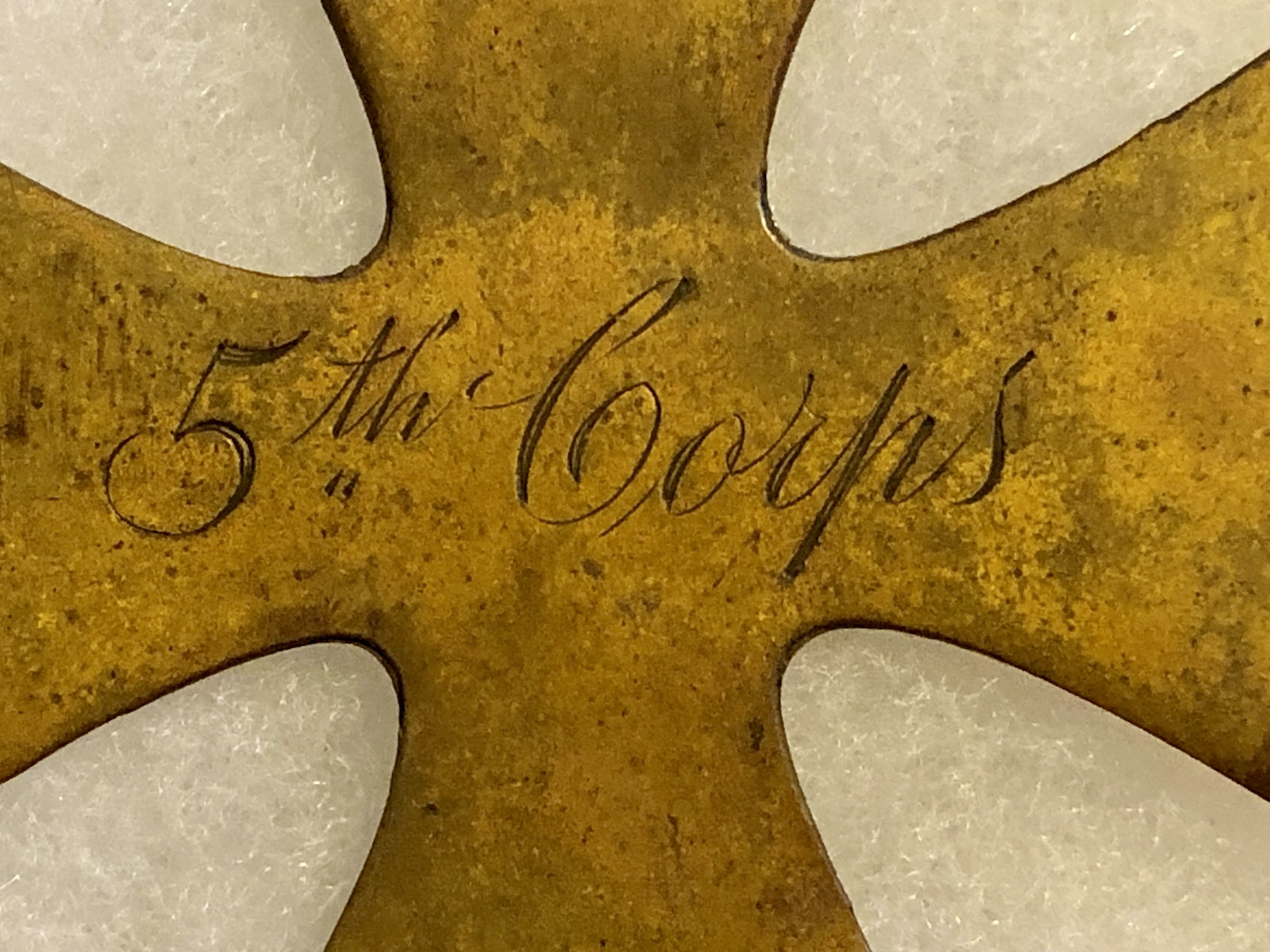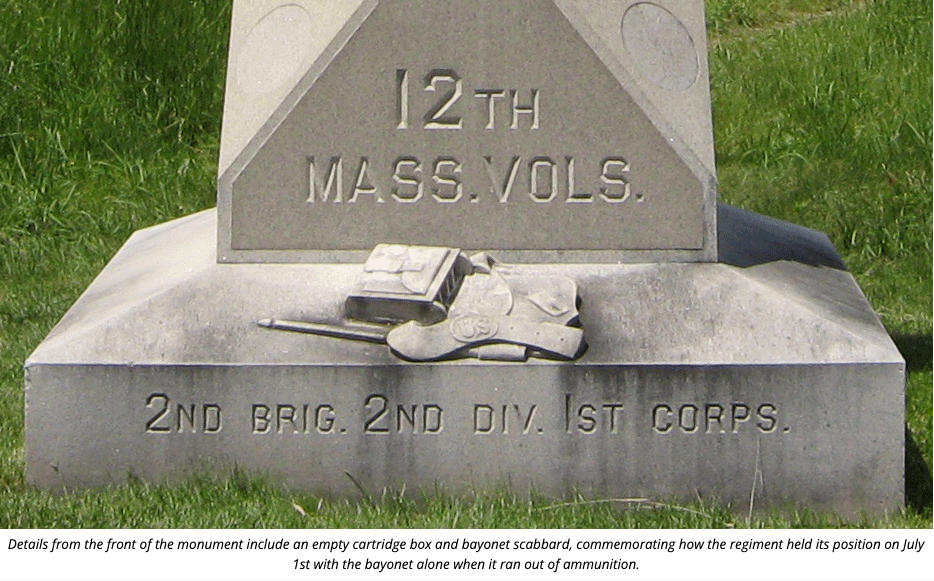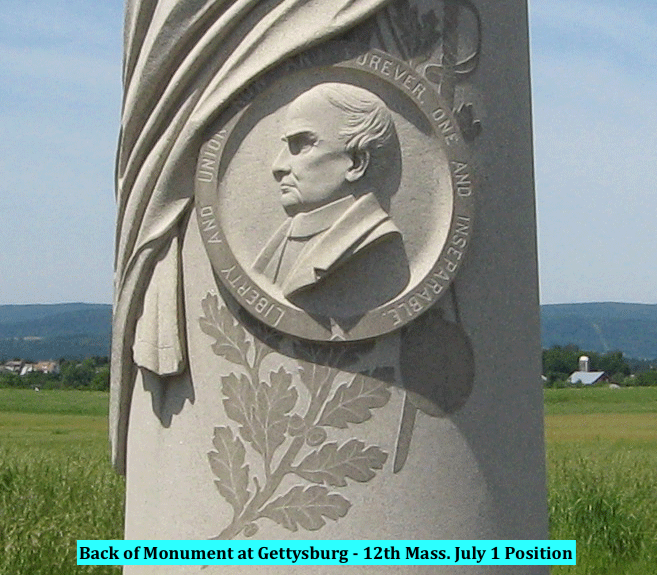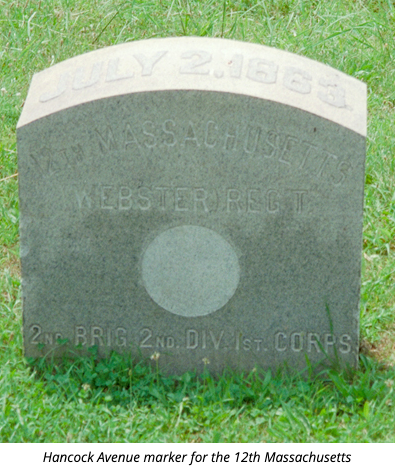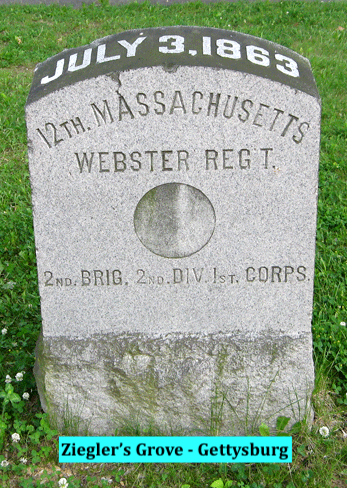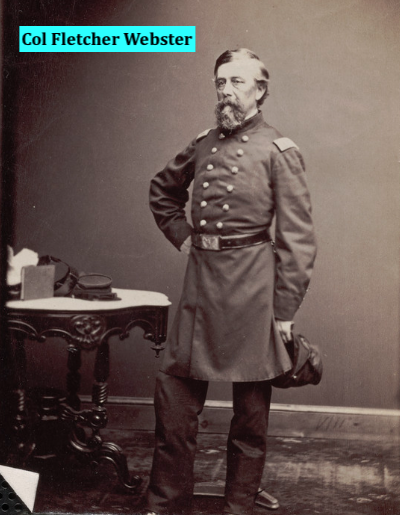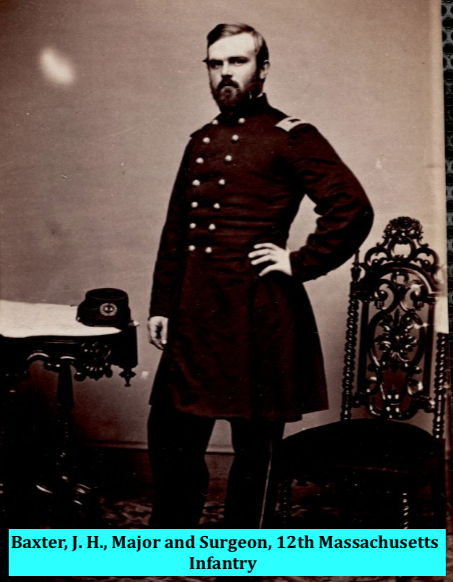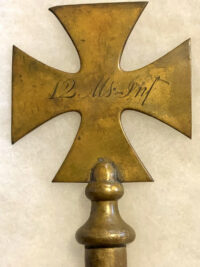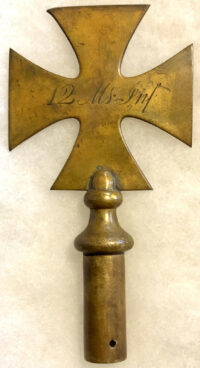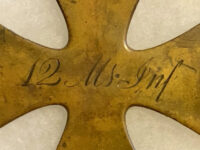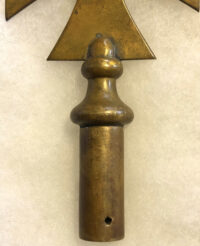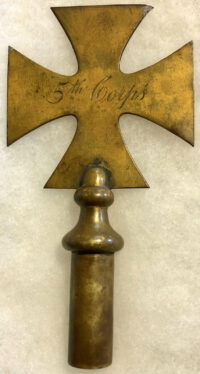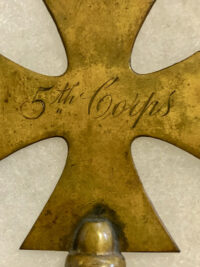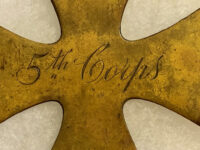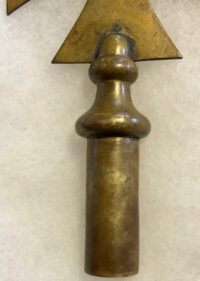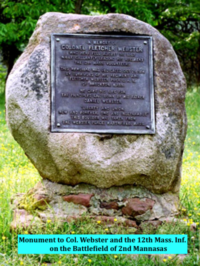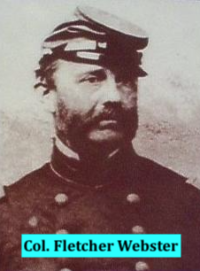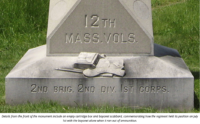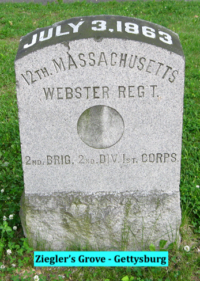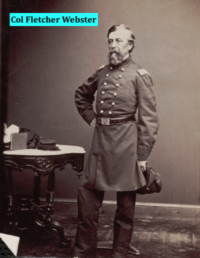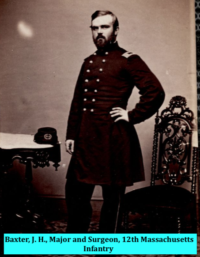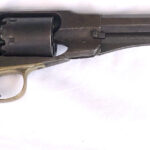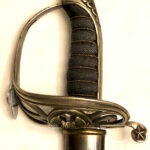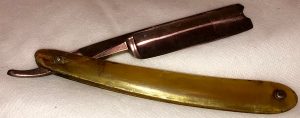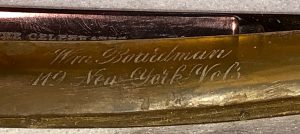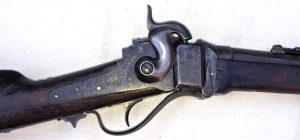Civil War Flag Staff Finial / Topper for the 12th Massachusetts Infantry 5th Corps
SOLD
Civil War Flag Staff Finial / Topper for the 12th Massachusetts Infantry 5th Corps – This rare regimental and corps, Civil War flag finial is finely engraved on one side of the large, 5th Corps emblem:
“12 Ms Inf”
On the opposite side is engraved:
“5th Corps”
The 12th Massachusetts Infantry was organized, in June, 1861, at Boston’s Ft. Warren, under the command of Col. Fletcher Webster, son of Daniel Webster; the regiment became known as the “Webster Regiment” in honor of Daniel Webster and his son, Col. Webster, who was killed in action, at the Second Battle of Manassas. The 12th Mass. would participate in many engagements during their four years of service, to include: the Battle of Cedar Mountain, 2nd Manassas, The Battle of South Mountain, Antietam (sustained 67% casualties – highest in the Union Army at Antietam), Fredericksburg, Chancellorsville, Gettysburg, The Wilderness, Spotsylvania Courthouse, Cold Harbor and the initial assault on Petersburg. There are monuments honoring the 12th Mass. on the battlefields of 2nd Manassas, Antietam and Gettysburg.
The flag finial is made of cast brass, in the shape of a 5th Corps emblem; the 12th Mass. would serve briefly in the 1st and 3rd Corps, but spent the majority of their service in the 5th Corps. The site of the flag staff insertion has one small hole where a screw or small nail would affix the finial to the flag staff. The finial remains in excellent condition; it exhibits a nicely aged, dark yellow patina. This finial represents a veteran infantry regiment, that saw highly significant action throughout the entire war.
Measurements: Total height – 5.25”; Width (across the corps designation) – 3”
12th Regiment, Massachusetts Infantry
OVERVIEW:
Organized at Fort Warren and mustered in June 26, 1861. Moved to Sandy Hook, Md., July 23-27. Attached to George H. Thomas’ Brigade, Dept. of the Shenandoah, to October, 1861. Abercrombie’s Brigade, Banks’ Division, Army of the Potomac, to March, 1862. 2nd Brigade, Williams’ 1st Division, Banks’ 5th Army Corps and Dept. of the Shenandoah, to May, 1862. 3rd Brigade, 2nd Division, Dept. of the Rappahannock, to June, 1862. 3rd Brigade, 2nd Division, 3rd Army Corps, Army of Virginia, to September, 1862. 3rd Brigade, 2nd Division, 1st Army Corps, Army of the Potomac, to November, 1862. 2nd Brigade, 2nd Division, 1st Army Corps, to March, 1864. 2nd Brigade, 2nd Division, 5th Army Corps, to May, 1864. 2nd Brigade, 3rd Division, 5th Army Corps, to July, 1864.
SERVICE:
Operations on the Upper Potomac August, 1861, to February, 1862. Operations opposite Edward’s Ferry October 21-24, 1861. Operations in the Shenandoah Valley March 24-April 27. Strasburg March 27. Edenburg April 1-2. Rappahannock Crossing April 18. Battle of Cedar Mountain August 9. Pope’s Campaign in Northern Virginia August 16-September 2. Rappahannock Station August 20-23. Thoroughfare Gap August 28. Bull Run August 30. Chantilly September 1. Maryland Campaign September-October. Battles of South Mountain September 14, and Antietam September 16-17. Duty at Sharpsburg till October 30. Movement to Warrenton, thence to Falmouth, Va., October 30-November 19. Battle of Fredericksburg December 12-15. “Mud March” January 20-24, 1863. At Falmouth and Belle Plain, Va., till April 27. Chancellorsville Campaign April 27-May 6. Operations at Pollock’s Mill Creek April 29-May 2. Fitzhugh’s Crossing April 29-30. Battle of Chancellorsville May 1-5. Gettysburg (Pa.) Campaign June 11-July 24. Battle of Gettysburg July 1-3. Picket duty on the Rapidan till October. Bristoe Campaign October 9-22. Advance to line of the Rappahannock November 7-8. Mine Run Campaign November 26-December 2. Demonstration on the Rapidan February 6-7, 1864. Campaign from the Rapidan to the James May-June, 1864. Battles of the Wilderness May 5-7; Laurel Hill May 8; Spottsylvania May 8-12; Spottsylvania Court House May 12-21. Assault on the Salient May 12. North Anna River May 23-26. Jericho Ford May 23. Line of the Pamunkey May 26-28. Totopotomoy May 28-31. Cold Harbor June 1-12. Bethesda Church June 1-3. White Oak Swamp June 13. Before Petersburg June 16-18. Ordered home for muster out June 25. Mustered out July 8, 1864.
Regiment lost during service 18 Officers and 175 Enlisted men killed and mortally wounded and 83 Enlisted men by disease. Total 276.
12th Massachusetts Infantry Regiment
| Memorial on the Manassas National Battlefield Park to Colonel Fletcher Webster, original commander of the 12th Massachusetts Infantry | |
| Active | June 14, 1861–July 8, 1864 |
| Country | United States of America |
| Allegiance | Union |
| Branch | Union Army |
| Type | Infantry |
| Size | 1,522 |
| Part of | In 1863: 2nd Brigade (Baxter’s), 2nd Division (Robinson’s), I Corps, Army of the Potomac |
| Nickname(s) | “Webster Regiment” |
| Commanders | |
| Notable commanders |
Colonel Fletcher Webster Colonel (later Brigadier General) James L. Bates |
The 12th Regiment Massachusetts Volunteer Infantry was an infantry regiment in the Union army during the American Civil War. It was formed on June 14, 1861, in Boston, Massachusetts. Its original commander was Colonel Fletcher Webster, son of the famed U.S. Senator from Massachusetts, Daniel Webster. The unit was known as the “Webster Regiment” after its first colonel.
Organization and early duty
Col. Webster began recruiting in April 1861 shortly after the attack on Fort Sumter. At that time, most recruits in Massachusetts were used to fill up the ranks in the existing state militia regiments, therefore it was several weeks before Webster had managed to recruit a full regiment. The unit was trained at Fort Warren in Boston harbor. On July 19, 1861, the regiment was reviewed by Governor John Albion Andrew on Boston Common and presented with its colors. On July 23, the 12th Massachusetts departed Boston for the war front.
The regimental surgeon was Jedediah Hyde Baxter, son of Congressman Portus Baxter. J. H. Baxter later served as Surgeon General of the United States Army.
The regiment was first assigned to the Army of the Shenandoah under the command of Major General Nathaniel P. Banks. Until the spring of 1862, the regiment was employed in uneventful picket duty in the vicinity of Frederick, Maryland. In late February, the 12th Massachusetts, as part of Brigadier General John Abercrombie‘s brigade, moved into Virginia. On April 18, 1862, while on picket duty along the Rappahannock River the men of the 12th Massachusetts exchanged sporadic fire with Confederates on the other side of the river. This was the first time the unit was engaged in hostile fire.
At the Battle of Antietam, the regiment lost 67% of its strength, or 224 of 334 men. It was the highest percentage casualty rate of any Union regiment in the battle.
Notable members
- Colonel Fletcher Webster—son of Congressman Daniel Webster.
- Private John Edward Gilman, Company E – 40th Commander-in-Chiefof the Grand Army of the Republic, 1910-1911
12th Massachusetts Volunteer Infantry Regiment
“The Webster Regiment”
The 12th Massachusetts Infantry Regiment lost 18 officers and 175 enlisted men killed or mortally wounded and 83 enlisted men to disease during the Civil War. It was named after its first colonel, Fletcher Webster, and in honor of his father, Daniel Webster. The regiment is honored by a monument at Gettysburg. Colonel Webster is honored by a monument on the battlefield of Bull Run.
| 1861 | |
| June 26 | Organized at Fort Warren and mustered in under Colonel Fletcher Webster |
| July 23-27 | Moved to Sandy Hook, Md. and attached to George H. Thomas’ Brigade, Dept. of the Shenandoah |
| August | Operations on the Upper Potomac |
| October | Attached to Abercrombie’s Brigade, Banks’ Division, Army of the Potomac |
| October 21-24 | Operations opposite Edward’s Ferry |
| 1862 | |
| March | Assigned to 2nd Brigade, Williams’ 1st Division, Banks’ 5th Army Corps |
| March 24 – April 27 |
Operations in the Shenandoah Valley |
| March 27 | Strasburg |
| April 1-2 | Edenburg |
| April 18 | Rappahannock Crossing |
| May | Assigned to 3rd Brigade, 2nd Division, Dept. of the Rappahannock |
| June | Assigned to 3rd Brigade, 2nd Division, 3rd Army Corps, Army of Virginia |
| August 6 | Captain James Bates of Company H promoted to major of the 33rd Massachusetts Infantry |
| August 9 | Battle of Cedar Mountain |
| August 16 – September 2 |
Pope’s Campaign in Northern Virginia |
| August 20-23 | Rappahannock Station |
| August 28 | Thoroughfare Gap |
| August 30 | Second Battle of Bull Run
Colonel Webster was killed and Major Elisha Burbank took command of the regiment |
| September 1 | Chantilly |
| September | Assigned to 3rd Brigade, 2nd Division, 1st Army Corps, Army of the Potomac |
| September – October | Maryland Campaign |
| September 14 | Battle of South Mountain |
| September 16-17 | Battle of Antietam
Major Elisha Burbank commanded the 334 men of the regiment until he was mortally wounded in the Cornfield. The regiment lost 49 killed and 165 wounded. Captain Benjamin F. Cook took command after Major Burbank fell. From the brigade marker on the Antietam battlefield: Hartsuff’s Brigade, advancing from the Poffenberger Woods early on the 17th, passed through the northern part of the East Woods and over the open ground west of them, and went into action on a line running northwest and southeast through this point. Early in the movement Gen. Hartsuff was wounded and the command devolved upon Col. Richard Coulter, 11th Pennsylvania Infantry. The left center of the 11th Pennsylvania was at this point with the 12th Massachusetts on the right. On the immediate left of the 11th was the 13 Massachusetts and on its left was the 83rd New York. In this position, supported by two Regiments of Christian’s Brigade, it maintained a sanguinary contest in which it lost half its number, but was compelled to withdraw, being relieved by the advance of Crawford’s Brigade, Twelfth Corps. The Brigade carried into action about 1220 men of whom 82 were killed and 497 wounded. The 12th Massachusetts lost 224 out of 334 engaged. |
| September 18 – October 30 | Duty at Sharpsburg |
| September 19 | Major Bates returned to the regiment from the 33rd Massachusetts Infantry and was promoted to colonel |
| October 30 – November 19 | Movement to Warrenton, thence to Falmouth, Va., |
| November | Assigned to 2nd Brigade, 2nd Division, 1st Army Corps |
| December 12-15 | Battle of Fredericksburg |
| 1863 | |
| January 20-24 | “Mud March” |
| January 25 – April 27 |
At Falmouth and Belle Plain, Va. |
| April 27-May 6 | Chancellorsville Campaign |
| April 29-May 2 | Operations at Pollock’s Mill Creek |
| April 29-30 | Fitzhugh’s Crossing |
| May 1-5 | Battle of Chancellorsville |
| June 11-July 24 | Gettysburg Campaign |
| July 1-3 | Battle of Gettysburg
Commanded by Colonel James L. Bates until he was wounded on July 1. Lieutenant Colonel David Allen, Jr. then took over the regiment. The regiment fought on July 1 on the northern end of the Fereral line along Oak Ridge. For a time on the afternoon of July 1st the regiment ran out of ammunition and held its position with fixed bayonets alone. This is commemorated on the regiment’s monument with an empty cartridge case and bayonet scabbard. On July 2 the regiment supported the Second Corps line on Cemetery Ridge, and on July 3 was in Ziegler’s Grove during Pickett’s Charge. The 12th Massachusetts brought 301 men to the field, losing 5 killed, 52 wounded and 62 missing. |
| July – October | Picket duty on the Rapidan |
| October 9-22 | Bristoe Campaign |
| November 7-8 | Advance to line of the Rappahannock |
| November 26- December 2 | Mine Run Campaign
Commanded by Major Benjamin Cook |
| 1864 | |
| February 6-7 | Demonstration on the Rapidan |
| March | Assigned to 2nd Brigade, 2nd Division, 5th Army Corps |
| May-June | Campaign from the Rapidan to the James |
| May 5-7 | Battle of the Wilderness |
| May 8 | Laurel Hill |
| May | Assigned to 2nd Brigade, 3rd Division, 5th Army Corps. Colonel Bates commanded the brigade while Major Cook commanded the regiment. |
| May 8 – 21 | Battle of Spotsylvania Court House |
| May 12 | Assault on the Salient |
| May 23-26 | North Anna River |
| May 23 | Jericho Ford |
| May 26-28 | Line of the Pamunkey |
| May 28-31 | Totopotomoy |
| June 1-12 | Cold Harbor |
| June 1-3 | Bethesda Church |
| June 13 | White Oak Swamp |
| June 16-18 | First Assault on Petersburg |
| June 25 | Ordered home for muster out |
| July 8 | Mustered out under Colonel Bates and Lieutenant Colonel Cook |


